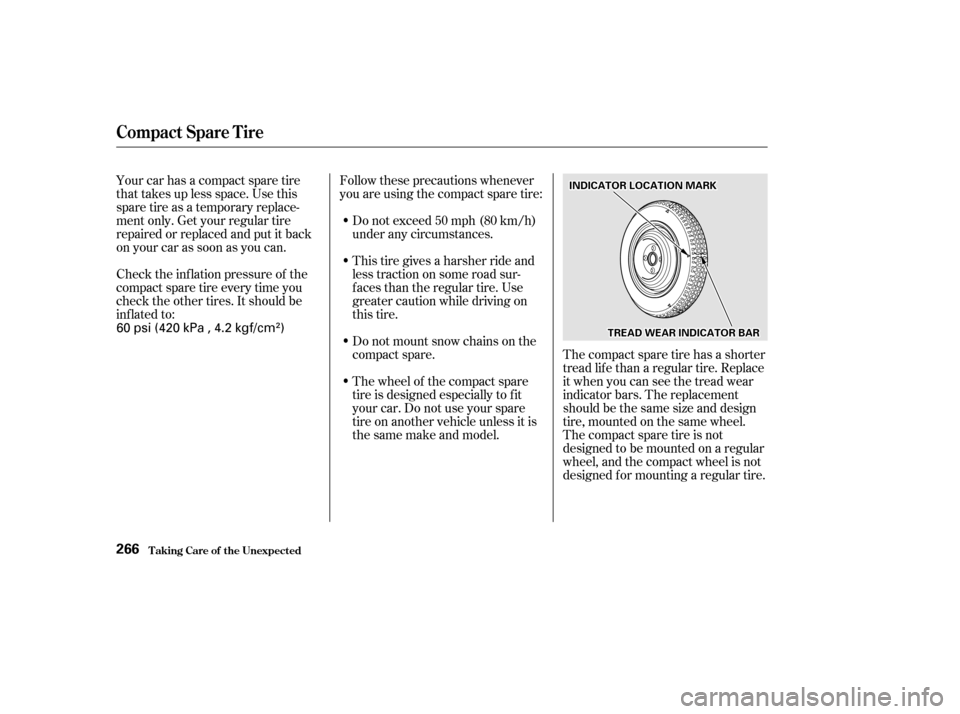Page 256 of 321

Regular cleaning and polishing of
your Honda helps to keep it ‘‘new’’
looking. This section gives you hints
on how to clean your car and
preserve its appearance: the paint,
brightwork, wheels and interior. Also
included are several things you can
do to help prevent corrosion..................................
Exterior Care . 258
.....................................
Washing . 258
.......................................
Waxing . 259
..........................
Paint Touch-up . 259
..................................
Interior Care . 260
...................................
Carpeting . 260
.................................
Floor Mats . 260
.........................................
Fabric . 261
...........................................
Vinyl . 261
...................................
Seat Belts . 261
....................................
Windows . 262
..........................
Air Fresheners . 262
....................
Corrosion Protection . 263
.................................
Body Repairs . 264
Appearance Care
Appearance Care257
Page 262 of 321

Two f actors normally contribute to
causing corrosion in your car:Moisture trapped in body cavities.
Dirtandroadsaltthatcollectsin
hollows on the underside of the
car stays damp, promoting
corrosion in that area.
Removal of paint and protective
coatings f rom the exterior and
underside of the car. Many corrosion-preventive measures
are built into your Honda. You can
help keep your car f rom corroding
by perf orming some simple periodic
maintenance:
Repair chips and scratches in the
paint as soon as you discover them.
Inspect and clean out the drain
holes in the bottom of the doors
and body.
Check the f loor coverings f or
dampness. Carpeting and f loor
mats may remain damp f or a long
time, especially in winter. This
dampness can eventually cause
the f loor panels to corrode. Use a high-pressure spray to clean
the underside of your car. This is
especially important in areas that
useroadsaltinwinter.Itisalsoa
good idea in humid climates and
areas subject to salt air. Cars
equipped with ABS have a sensor
and wiring at each wheel. Be
caref ul not to damage them.
Have the corrosion-preventive
coatings on the underside of your
car inspected and repaired
periodically.
1. 2.
Corrosion Prot ect ion
Appearance Care263
Page 265 of 321

Follow these precautions whenever
you are using the compact spare tire:Thecompactsparetirehasashorter
tread lif e than a regular tire. Replace
it when you can see the tread wear
indicator bars. The replacement
should be the same size and design
tire, mounted on the same wheel.
Thecompactsparetireisnot
designed to be mounted on a regular
wheel, and the compact wheel is not
designed f or mounting a regular tire.
Check the inf lation pressure of the
compact spare tire every time you
check the other tires. It should be
inf lated to:
Do not exceed 50 mph (80 km/h)
under any circumstances.
This tire gives a harsher ride and
less traction on some road sur-
f aces than the regular tire. Use
greater caution while driving on
this tire.
Do not mount snow chains on the
compact spare.
Your car has a compact spare tire
that takes up less space. Use this
sparetireasatemporaryreplace-
ment only. Get your regular tire
repaired or replaced and put it back
on your car as soon as you can.
The wheel of the compact spare
tire is designed especially to f it
your car. Do not use your spare
tire on another vehicle unless it is
thesamemakeandmodel.
Compact Spare Tire
T aking Care of t he Unexpect ed266
IINNDDIICCAATTOORRLLOOCCAATTIIOONNMMAARRKK
TTRREEAADDWWEEAARRIINNDDIICCAATTOORRBBAARR60 psi (420 kPa , 4.2 kgf/cm)
Page 267 of 321
Turn the jack’s end bracket
counterclockwise to loosen it, then
remove the jack.Loosen the f our wheel nuts 1/2
turn with the wheel wrench.
Find the jacking point nearest the
wheel you are removing. Place the
jack under the jacking point. Turn
the end bracket clockwise until
the top of the jack contacts the
jacking point. Make sure the
jacking point tab is resting in the
jack notch.
6.
7.8.
T aking Care of t he Unexpect ed
Changing a Flat T ire
268
JJAACCKK
WWHHEEEELLWWRREENNCCHH
JJAACCKKIINNGGPPOOIINNTTSS
Page 268 of 321
CONT INUED
Remove the wheel nuts and wheel
cover. The wheel cover cannot be
removed without f irst removing
the wheel nuts. Do not attempt to
f orcibly pry the wheel cover of f
with a screwdriver or other tool.
Use the extension and wheel
wrench as shown to raise the car
until the f lat tire is of f the ground.
Remove the f lat tire. Temporarily
place the f lat tire on the ground
with the outside surface of the
wheel f acing up. You could scratch
the wheel if you put it f ace down.
9.
10. 11.
Changing a Flat T ire
T aking Care of t he Unexpect ed269
WWHHEEEELLWWRREENNCCHHEEXXTTEENNSSIIOONN
WWHHEEEELLNNUUTTSS
WWHHEEEELLCCOOVVEERRWWHHEEEELLNNUUTTSS
Page 269 of 321
Lowerthecartothegroundand
remove the jack.
Put on the spare tire. Put the
wheel nuts back on f inger-tight,
then tighten them in a crisscross
pattern with the wheel wrench
until the wheel is f irmly against
the hub. Do not try to tighten
them f ully.
Bef ore mounting the spare tire,
wipeanydirtoff themounting
surface of the wheel and hub with
a clean cloth. Wipe the hub
carefully,itmaybehotfrom
driving.
12. 13.
14.
T aking Care of t he Unexpect ed
Changing a Flat T ire
270
BBRRAAKKEEHHUUBB
Page 270 of 321
Store the wheel cover in the trunk.
Make sure it does not get
scratched or damaged.
Tighten the wheel nuts securely in
the same crisscross pattern. Have
the wheel nut torque checked at
the nearest automotive service
f acility.
Tighten the wheel nuts to: Place the flat tire face down in the
spare tire well.
Remove the spacer cone f rom the
wing bolt, turn it over, and put it
back on the bolt.
Securetheflattirebyscrewing
the wing bolt back into its hole.Store the jack in the trunk with the
end bracket on the lef t side. Turn
the jack’s end bracket to lock it in
place. Store the tool kit.
Lower the trunk f loor and trunk
floor mat, then close the trunk lid.
15. 16.
17.
18. 19.
20.
21.
Changing a Flat T ire
T aking Care of t he Unexpect ed271
WWIINNGGBBOOLLTTSSPPAACCEERRCCOONNEE
80 lbf·ft (108 N·m , 11 kgf·m) Loose items can fly around the
interiorinacrashandcould
seriously injure the occupants.
Store the wheel, jack, and tools
securely before driving.
Page 282 of 321

�Î�Î
�Î�ÎSlow down by shif ting to a lower
gear, and pull to the side of the road
when it is saf e. Because of the
longer distance needed to stop, it is
hazardous to drive the car. You
should have it towed, and repaired as
soon as possible. (Seeon page .)
If you must drive the car a short
distance in this condition, drive
slowly and cautiously.
If it comes on at any other time, it
indicates a problem with the car’s
brake system. In most cases, the
problem is a low f luid level in the
brake f luid reservoir. Press lightly on
the brake pedal to see if it f eels
normal. If it does, check the brake
f luid level the next time you stop at a
service station (see page ). If the
fluid level is low, take the car to your
dealer and have the brake system
inspected f or leaks or worn brake
pads.
However, if the brake pedal does not
f eel normal, you should take
immediate action. Because of the
brake system’s dual-circuit design, a
problem in one part of the system
will still give you braking at two
wheels. You will f eel the brake pedal
go down much f arther bef ore the car
begins to slow down, and you will
have to press harder on the pedal.
The distance needed to stop will be
much longer.
The Brake System Indicator
normallycomesonwhenyouturn
the ignition switch ON (II). It is a
reminder to check the parking brake.
It comes on and stays lit if you do not
f ully release the parking brake.
222
290Emergency
Towing
Brake System Indicator
T aking Care of t he Unexpect ed283
UU..SS..iinnddiiccaattoorrsshhoowwnn
BBRRAAKKEESSYYSSTTEEMMIINNDDIICCAATTOORR